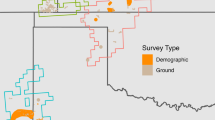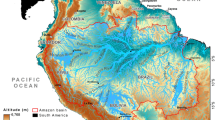Abstract
We present a length-structured matrix model for fish populations in which the probability that a fish grows into the next length class is a decreasing nonlinear function of the total biomass of the population. We present mathematical results classifying the dynamics that this density-dependent model predicts. We illustrate these results with numerical simulations for an invasive white perch population and show how the mathematical results can be used to predict the persistence and/or boundedness of the population as well as an equilibrium structure that is dominated by small fish. We illustrate the results with management recommendations for an invasive white perch population.



Similar content being viewed by others
Change history
17 June 2021
A Correction to this paper has been published: https://doi.org/10.1007/s11538-021-00916-1
References
Catalano MJ, Allen MS (2010) A size-and age-structured model to estimate fish recruitment, growth, mortality, and gear selectivity. Fish Res 105(1):38–45
Chizinski CJ (2007) Life-history and morphological variation in stunted and non-stunted fish. Dissertation, Texas Tech University
Chizinski CJ, Pope KL, Wilde GR (2010) A modelling approach to evaluate potential management actions designed to increase growth of white perch in a high-density population. Fish Manag Ecol 17:262–271
Cushing JM (1991) Competing size-structured species. In: Arino O, Axelrod DE, Kimmel M (eds) Mathematical population dynamics, chap 3. Marcel Dekker, Inc., NY, pp 27–44
Cushing JM (1992) A discrete model for competing stage-structured species. Theor Popul Biol 41(3):372–387
Cushing JM (1998) An introduction to structured population dynamics. Society for Industrial and Applied Mathematics, Philadelphia
Cushing JM, Yicang Z (1994) The net reproductive value and stability in matrix population models. Nat Resource Model 8(4):297–333
Ellner SP, Childs DZ, Rees M (2016) Data-driven modelling of structured populations. Lecture Notes on Mathematical Modelling in the Life Sciences. Springer, Berlin
Fournier DA, Hampton J, Sibert JR (1998) MULTIFAN-CL: a length-based, age-structured model for fisheries stock assessment, with application to South Pacific Albacore, Thunnus alalunga. Can J Fish Aquat Sci 55(9):2105–2116
Frøysa KG, Bogstad B, Skagen DW (2002) Fleksibest—an age-length structured fish stock assessment model. Fish Res 55:87–101
Hergenrader GL, Bliss QP (1971) The white perch in Nebraska. Trans Am Fish Soc 100:734–738
Jackson LF, Sullivan CV (1995) Reproduction of white perch—the annual gametogenic cycle. Trans Am Fish Soc 124:563–577
Meyer C (2000) Matrix analysis and applied linear algebra. Society for Industrial and Applied Mathematics, Philadelphia
Schnute J (1987) A general fishery model for a size-structured fish population. Can J Fish Aquat Sci 44(5):924–940
Shields JT (1958) Experimental control of carp reproduction through water drawdowns in Fort Randall Reservoir, South Dakota. Trans Am Fish Soc 87:23–33
Smith HL, Thieme HR (2011) Dynamical systems and population persistence. American Mathematical Society, Providence
Smith HL, Thieme HR (2013) Persistence and global stability for a class of discrete time structured population models. Discrete Contin Dyn Syst Ser A (DCDS-A) 33(10):4627–4646
Sullivan PJ, Lai H-L, Gallucci VF (1990) A catch-at-length analysis that incorporates a stochastic model of growth. Can J Fish Aquat Sci 47(1):184–198
Townley S, Rebarber R, Tenhumberg B (2012) Feedback control systems analysis of density dependent population dynamics. Syst Control Lett 61(2):309–315
Wong RK (2002) White perch expansion and life history within a southern reservoir. Thesis, North Carolina State University
Yicang Z, Cushing JM (1998) Stability conditions for equilibra of nonlinear matrix population models. J Differ Equ Appl 4(2):95–126
Ylikarjula J, Heino M, Dieckmann U (1999) Ecology and adaptation of stunted growth in fish. Evol Ecol 13:433–453
Zheng J, Murphy MC, Kruse GH (1995) A length-based population model and stock-recruitment relationships for red king crab, Paralithodes camtschaticus, in Bristol Bay, Alaska. Can J Fish Aquat Sci 52(6):1229–1246
Author information
Authors and Affiliations
Corresponding author
Additional information
Publisher's Note
Springer Nature remains neutral with regard to jurisdictional claims in published maps and institutional affiliations.
This work was made possible through continuation funding from the Research Experiences for Undergraduate Faculty program supported by the National Science Foundation through Division of Mathematical Sciences Grants 1620073 to the American Institute of Mathematics and 1620080 to Institute for Computational and Experimental Research in Mathematics. Richard Rebarber was partially supported by National Science Foundation Division of Mathematical Sciences Grant 1412598.
Rights and permissions
About this article
Cite this article
Callahan, J., Eager, E., Rebarber, R. et al. Analysis of a Length-Structured Density-Dependent Model for Fish. Bull Math Biol 81, 3732–3753 (2019). https://doi.org/10.1007/s11538-019-00648-3
Received:
Accepted:
Published:
Issue Date:
DOI: https://doi.org/10.1007/s11538-019-00648-3




